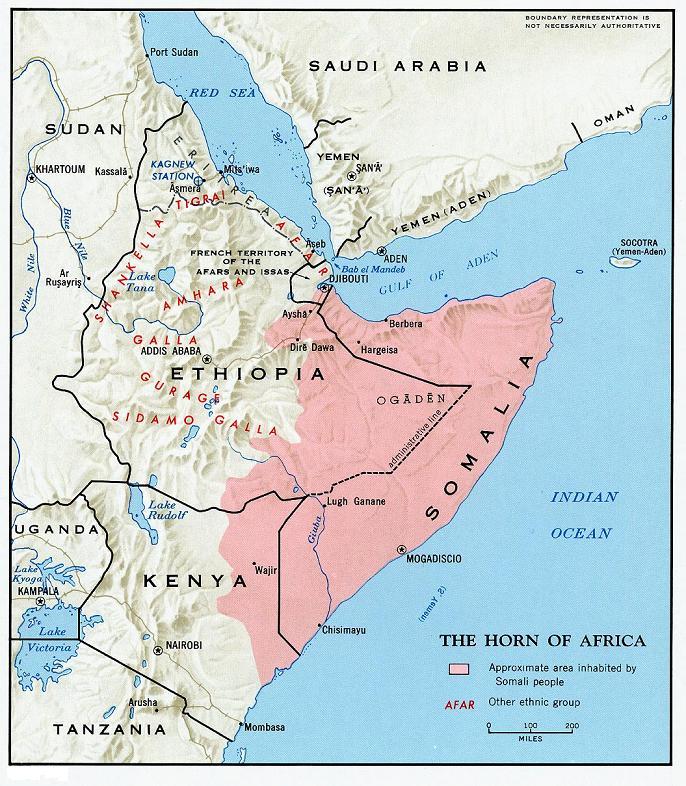Somali language in the world
The exact number of Somali speakers is unknown. The Somali language
is spoken by ethnic Somalis in Somalia, Djibouti, Ethiopia, Yemen and
Kenya. There are about 8 million Somali speakers in and around Somalia,
but combined with a large international diaspora, a reasonable estimate
could be between 10 to 16 million speakers worldwide.

What is Somali ?
The Somali language (Somali: Afsoomaali, Arabic: الصومالية)
is a member of the East Cushitic branch of the Afro-Asiatic language
family. Its nearest relatives are Afar and Oromo. Somali is the best
documented of the Cushitic languages, with academic studies dating
before 1900.
Somali is an agglutinative language, using a number of markers for
case, gender and number. Characteristic differences between Somali and
most Indo-European languages include multiple forms of most personal
pronouns, the use of particles to signify the focus of a sentence,
extensive use of tone to denote differences in case and number and
gender polarity.
Somali dialects are divided into 3 main groups : Northern, Benaadir and Maay.
- Northern Somali forms the basis for Standard Somali. It is spoken in Somaliland.
- Benaadir (also known as Coastal Somali) is spoken on the Benadir Coast from Cadale to south of Marka, including Mogadishu, and in the immediate hinterland.
- Maay is spoken mostly in Somalia and adjacent parts of Ethiopia and Kenya. Its speakers are known as Sab Somalis. The capital of the language is Baidoa.
Development of the Somali language
Before independence, very little has been written about the Somali
language. The very first comments on the Somali language, dating from
1844, were made by European colonizers. At the colonial administration
level, the languages which were used were English in the North
(Somaliland) and Italian in the South. The literate population used to
write in Arabic.
In the years after independence, the Somali language has gone through
three major phases : writing research, language development and
literacy campaigns. A few months after independence and the unification
of Somaliland and Somalia, a Commission of the Somali language was
created to find an acceptable writing system. The results and
suggestions of the Commission and those of the Commission of the UNESCO
that was later formed submitted two reports to the Somali government of
that time. Both reports examined a number of options: different
transcripts in Latin, Arabic and Osmaniya
alphabet, and the advantages and disadvantages of each system. But the
political factions in presence prevented the government from deciding in
favor of one system or another.
A few months after the revolution, the regime of Siad Barre took the
problem head on. The revolutionary government gave each of the three
factions a year to submit textbooks for all subjects in lower grades of
primary school - grades 1 to 4 - using their own resources. Only the
faction that was in favor of the Latin transcription finished work on
time.
Thus, on October 21, 1972, the transcription in Latin letters was officially adopted.
Then three stages of development quickly succeeded :
1. Make Somali the official language once the spelling was accepted.
2. Two years later, make Somali the medium of instruction in primary and secondary schools.
3. Make Somali a minor area of study at university.
Three literacy campaigns popularized the use of writing. For civil
servants and the urban population, it took 6 months to teach them to
read and write. For the rural population, there was nearly a year of
intensive teaching to which all pupils of the major classses in the
primary and secondary schools and the majority of civil servants
participated as teachers and inspectors.
These campaigns reached their climax with a literacy rate of 75% of
the population. Somalia won the UNESCO literacy medal in 1975.
The current status of the Somali language is significant. This is the
official language in Somalia and Somaliland (northern Somalia), and one
of the languages spoken in the Republic of Djibouti, parts of Ethiopia
and Kenya. Most education systems of these countries teach it, either as
a subject or use it as a medium of instruction, or both. There are more
than 20 radio and television broadcast stations in Somali worldwide.
Because refugees are on their soil, several European countries teach
their language to Somali children. A few universities, such as the
School of Oriental and African Studies of London (SOAS), the Swedish
Academy in Uppsala and the University of Rome have research programs in
this language.
Somali Vocabulary
Somalis being almost exclusively Sunni Muslims the language contains
many words of Arabic origin, both as regards the vocabulary of modern
institutions, such as government and economy, as the oldest Arabic terms
to discuss international trade and religion.
Somali also contains old Qahtani words, common to the Cushitic and
Semitic languages, and a number of loan words from Persian, and the
former colonial languages English and Italian.
Source: http://hooyo.web.free.fr
Source: http://hooyo.web.free.fr
No comments:
Post a Comment